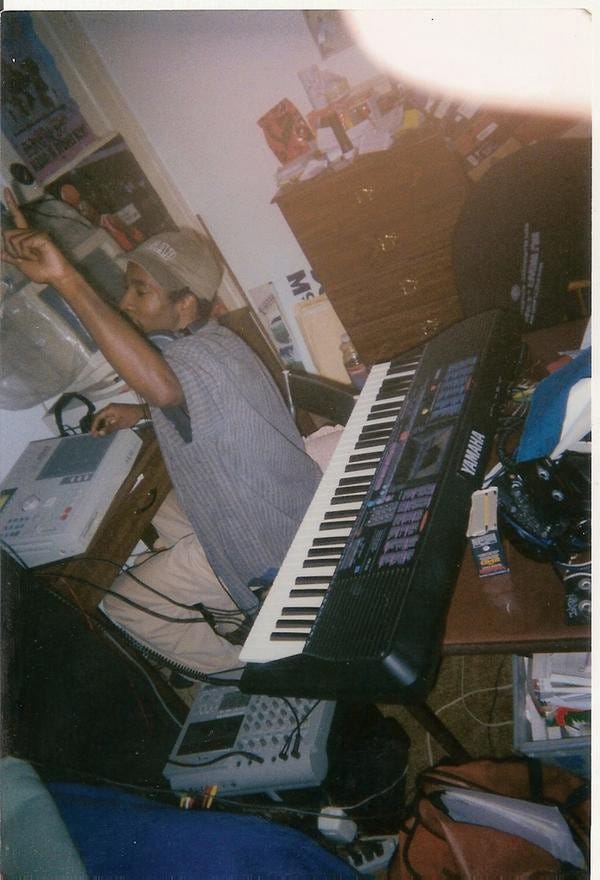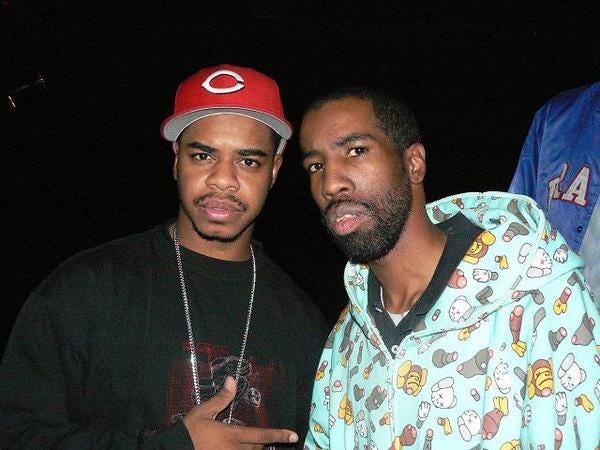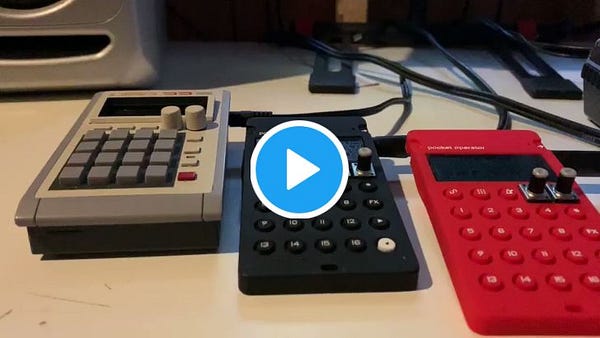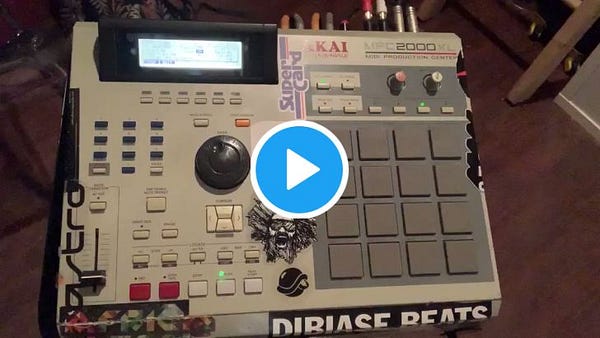Dibiase Discusses 303s, 404s, MPCs, and Tape Hiss—Part 1
The uncut, 6800-word version of an enduring Micro-Chop favorite in two parts.

Dibiase Discusses 303s, 404s, MPCs, and Tape Hiss—Part 1
This article is 6800 words long, so I’ll keep my opening brief.
I first published my interview with beatmaking legend Dibiase back in July of 2013 as a three-part series on my old blog. We discussed his music/work/life balance, Roland SP-303s and 404s, beat battles, the benefits of mixing hardware and software, early sampling methods with a Sony Walkman, the radio, and an 8-second sampler, and so much more.
The piece received a good deal of positive feedback and—along with a Nick Tha 1da interview I conducted—helped spark a desire within me to write in greater detail about beatmaking and music production. My former blog/website went through a brief Micro-Chop-esque phase, but I didn’t have to focus or know-how at the time to sustain it. It wasn’t until the summer of 2016 that I really dove back into writing headfirst.
One of the first things I did when I started a Medium account was was republish an edited version of my interview with Dibia$e. When I created the Micro-Chop publication on Medium to organize my articles, it quickly became one of the most-read stories on the site. Several years later, it remains an all-time Micro-Chop favorite.
Now that I have a much larger audience, it seems like a good time to revisit the original, uncut version. Much as I wanted to run it as a single long-form story, I had to break the interview into two parts due to length limits on Substack.
I hope you’ll take some time in the coming days to work through the entire thing and enjoy the vast selection of Dibiase’s music and performances I’ve included.

Gino Sorcinelli: I saw in an interview that you got your first sampler in ‘95. Have you been doing music non-stop since then?
Dibiase: Yeah, pretty much (Laughs). I started out rhyming. I was needing beats, so I started looping up stuff.
Gino: What made you decide to focus on producing?
Dibiase: Once I saw how active the beat battles were, I was like, “Man, I don’t even have to break a sweat rhyming.”
Then the beat scene grew and it was pretty much a wrap. I saw the homies traveling off of beats so I thought, “I better put everything in one basket instead of multi-tasking.”
Sometimes I get the urge to rhyme, but I’m not that focused with the writing.
Gino: How many hours a day would you say your spend working on beats?
Dibiase: Now that I’m working again, not that much. Sometimes I take the equipment to work. I probably spend like three hours a day on beats. But there was one point where I was like all day pretty much. I was doing the music full time from ‘08 until maybe eight months ago.
Gino: What made you decide to go back to mixing work with your music career?
Dibiase: I was kind of like you, doing the coaching and all that and working at a park. With that job, the schedule was flexible, so it was kind of easy to balance with the music. I wasn’t really travelin’ to other states or even out the country, so it was easy to do some shows and then drive to Hollywood after I clocked out of work or go to San Diego or The Bay.
Once I started travelin’, a little after Red Bull, that’s when I stopped working at the park. I had a booking agent and tried a few of them out. Now my wife does my booking. Once I got a booking agent, that’s when the shows started really picking up and I started going out the country a little more.
But the beat scene, it fluctuates sometimes. I had to get a little job on the side for the times when it’s like a dry spell. You know, you want to be comfortable. Sometimes I would stress out from chasing down money from selling beats. It would always come through, but the stressing out for years, I was over that. So I just got another job. Plus, when I moved out here to Sacramento, I had to get something. I was pretty much starting over because I’m from LA originally.
Gino: How is the re-adjustment to balancing work with music going?
Dibiase: The job I have now is similar to the park work I was doing, like a city job. I’m basically at a person’s house looking out for them while they’re sleeping. I have my equipment and I pretty much just make beats. It’s kind of a chill job. I was trying to get something that wasn’t too stressful so I could balance the two. They’re pretty good on the schedule and I get time off, so it’s cool.
Gino: I’m glad to hear it hasn’t been a negative experience. Work can definitely consume your drive to be creative.
Dibiase: I’m getting older now, but when I was younger, when I was working at the park, shit, it didn’t even matter. I would write rhymes, make the beat, record the song, go to work, and come back at night. I’d do the same thing, stay up, and repeat the process. Then on my off days, the homies were living in Fullerton, so I’d crash out there for the weekend and go on a beat binge. I’d knock out 20 beats in a weekend and call it a day. That was like 07.
Gino: If you have a weekend with free time, can you still churn out 10, 15, or 20 beats in a weekend, or is that hard to do?
Dibiase: No. I was single at the time. All I had was my job and I’d be at the homies house so I could afford to lock myself in the lab. Now, I have a lot of responsibility, so I can’t lock myself in the lab on some all-day shit. But sometimes I’ll crank out like five or six beats on a good day.
Gino: I know you still use the Roland SP-404 a lot. When we spoke before this interview, you were saying that for the last couple of projects you used programs like Ableton. Are you using more software these days?
Dibiase: Swingology101 was done with Reason 5. I’ll make a beat on Reason and then run it through the 303 or 404 for its compression to dirty it up. A lot of times I combine stuff. Back in the day I just had the Akai MPC2000XL and 303 and that was it. I had a cool workflow because I was using the MP for so long.
Now that I’ve learned all of this software, sometimes I’m combining three different things and running it through the 303, just re-sampling stuff, and it be taking some time just to get certain effects. Back in the day I wasn’t doing all that. I would just make a beat and record it straight to an external CD burner. I wasn’t even messing with computers back then.
Gino: Which sampler has a better workflow for you, the MPC or the 303?
Dibiase: I like the MP but I felt limited at the time. I wanted to have effects and filters with certain beats I made on the MP. If I wanted filters, I had to sample the MP through a 303 or a CDJ just to get the wah-wah effects. With software the effects are built in already. All you do is add the little auto filter, then map your knobs and you got your instant filter. With the hardware, it might have been harder, but it kept you occupied, and it kept you thinking.
Gino: So using a combination allows you to grow a little bit and become more layered?
Dibiase: Yeah. Combining the two is like the best of both worlds. I hear a lot of people clowning Fruity Loops and all that. Back in the day I used to be like, “I’ll never mess with software.”
I was holding myself back all those years. It’s good to use both. Once I started doing that, that’s when stuff started getting serious. I started entering the beats battles and winning them.
Gino: What is your proudest accomplishment from the time you spent doing beat battles?
Dibiase: The Red Bull definitely. Just getting accepted to it was an accomplishment. And I was lucky enough to win it and be runner up. I used to enter mad battles in San Francisco and throughout L.A. Sometimes I would just catch a Greyhound from L.A. to The Bay and I would end up winning it. I was taking a little chance man. If I won it, I won it. If not, all good. I was getting a place to play some beats on loud speakers. That was the cool thing.
Gino: You were getting to introduce a new audience to what you were doing.
Dibiase: Yeah. The battles there were kind of challenging because they would give you samples and sometimes they had challenges where you had to flip a remix. It was fun. The battles in L.A. were called the Hotel Room battles. They used to have MC battles, and then they started having the beat battles. Pretty much everyone used to enter them. Mike Gao, TOKiMONSTA, P.U.D.G.E…all kinds of beat cats in the scene were entering them. It definitely kept your sword sharp going against everyone. This was around ‘08 or ‘09.
Gino: I’ve seen a lot of YouTube footage of you rocking the SP 404 live. Were you using it at all in those battles?
Dibiase: No. They weren’t live battles like that. You would just make the beat at home and then bring your CD. In 2006 or 2007 they did have battles in L.A. at this record store called Rehab and you’d have to bring your MPC. They would have performances in the beginning of the night with cats rhyming, and all of the producers would be at the back, like 16 cats with they MPs. Everybody had two hours to flip the same record and get they drums from a breakbeat record. After all of the performances was over, everybody would come to the back and plug they MP up to the monitor speakers. That was the first beat battle I was in where I was making the beats under pressure.
Gino: What's the atmosphere like in that situation? Is there any talking or is it really competitive?
Dibiase: Those battles were cool. Some of the homies in my crew were in it as well. I was in a crew called Missing Page back in the day, like 2005. Pretty much everyone rhymed and made beats except for a few cats. We were all entering the beat battles. One of the other homies from Japan, Budamunk, was living in L.A. at the time, and he was entering them battles too. So he was in them and my homie who was in Fullerton was in those battles. It wasn’t aggressive or nothing.
Some of them Red Bull battles seemed aggressive. A lot of egos. I was in a few beat battles in San Diego back in the day that was kind of aggressive and cats bit my style. Just like bold face bit, came up to me before we battled and said, “Yo, I got something for you. I made something just for you.”
Then they would flip a beat that I’d flip, the same samples, like some video game shit, and play it against me. I was just like, “Wow, OK” (Laughs).
Dude ended up winning. We went to overtime. I thought I got ‘em in the first round, but they had judges that night. It went in his favor and he ended up winning the whole thing. Other than that I don’t be taking losses too serious.
Gino: That could be seen as a good thing. If other people are making stuff specifically for you, you know they’re considering you one of the top producers in the battle.
Dibiase: Yeah, I guess you can see it that way. I’m pretty much retired from the battles now. It was fun for a while. I get the itch to enter some, but I’m just on the live shows now. I’m trying to build that and improve on that.
Gino: In a lot of the footage of you that I’ve seen you’re using one or two 404s. Is that your weapon of choice for live shows?
Dibiase: Sometimes I’ll use the MP, but I haven’t used that in a minute. I use Ableton as well, and sometimes I’ll use Ableton and the 404 together and go back and forth between the two. But yeah, I’ve mixed it up throughout the years. I was using the 303 with a laptop, but I couldn’t get enough sampling time on it. With live shows, you could get maybe 15 minutes.
It’s funny; all of the homies like Ras G and Samiyam were rocking the 303s back in the day for shows. I remember when Ras G went overseas for the first time. He had to use my 303 when he went so he could have at least 30 minutes of sampling time. He didn’t have a laptop, he just had the MP and a 303, so I let him use my 303 because I had a 404. I was telling him, “Yo, you can fit hours into a 404. It’s pretty much the same as a 303 but it got more effects.” They were sticking to the 303 religiously, until the 303s started breaking down. Then they started getting the 404.
Gino: The SP-303 isn’t the most advanced sampler, yet everyone from Madlib and Dilla to artists like Beck and Four Tet have used it for recording and performing. I had heard about Madlib and Dilla using the 303, but I had no idea so many people used it before I started researching for this piece. Have most people abandoned it now that there are more advanced Roland SPs and other samplers? Or do you still think a lot of people still use the 303s?
Dibiase: I know I keep the 303 because I like the sound quality of it. The difference between the 303 and 404 is that the vinyl sound compression sounds way different in the 303. It has a grittier sound. I know a lot of homies might make their beats on the 404 and then double compress it by dumping it into the 303, and then dumping it back to the 404. There be a lot of bouncing back and forth. I’ll do some of the effects the 303 doesn’t have on the 404, dump it into the 303, use the 303s compressor and vinyl sound compression, and then dump it back into the 404. (Laughs) It’s crazy man. That’s what takes all the time, but it gets a good lo-fi sound. The lo-fi on the 303 sounds different than the 404.
Another feature that I wish the 404 had is the one I use on the 303 when I’m re-sampling to make beats. You know the external source button on the 303 and 404? When the external source button is lit up, it’s sampling the record you got going through the sampler from your turntable. On the 404, say you’re playing some drums that you already got on the drum pads. The record is playing, and you want to sample it all at the same time. You can’t do that on the 404, but on the 303 you can.
Gino: So with the 303 you can play sounds over a record playing on a turntable and sample it all at once?
Dibiase: Yeah. Say you already have a kick and a snare on the 303 on button 1 and 2 and you're playing the pattern out, and you have a sample on the record playing from the turntable directly into the external source. You just hit record and you can sample that all in and play a live drum pattern over the record playing. So you sample that, and then you can chop that up.
Gino: That’s crazy.
Dibiase: Yeaah. But the 404 can’t do that shit and it’s supposed to be an upgrade. (Laughs)
Gino: It seems like whenever Roland made an upgrade to the SP series, they would drop some crucial features.
Dibiase: And that was the most gangster feature. But that software Maschine has a feature like that. I like Maschine because it does that. If you have the beat playing in the 303 and you’re playing a bassline from an external keyboard, you can sample that on top of the beat live, but you can’t separate none of that stuff ‘cause it’s all on one pad. That’s why you have to think about how to mix your stuff down all in one take and get a balanced mix. Once you get it in there, there’s no lowering or raising the volumes up. That’s why it sounds so raw.
Gino: Right. The limitations of the machine force you to be creative. I think a lot of people are surprised when they learn about who has used the 303 to make dope music. And it definitely maintains a crazy, gritty sound.
Dibiase: That’s my favorite stuff…some of my favorite to make. A lot of people label me electronic, which is crazy. I feel like I’m like a traditional boom bap head.
Gino: Do you think that’s because of the effects you put on some of your beats?
Dibiase: Maybe. Some of the effects and some of the other albums I dropped like Machines Hate Me was more electronic. Yeah, a lot of stuff gets put in that electronic category.
Gino: I would not classify Swingology 101 or Collectin’ Dust as electronic.
Dibiase: Collectin’ Dust is a lot of my old MPC beats.
Gino: To me, that sounds like vintage ‘90’s shit.
Dibiase: Yeah, that was close to ‘90s. It ranged from 2000 to like ‘04. My stuff from the ‘90s, those is on four track tapes. I need to get a 4-track. Matthewdavid digitized a few tapes for me. Shit, I’m a little embarrassed to put those ‘90s tapes on the Soundcloud. It sounds a little bugged out.


Gino: You had an 8-second sampler back then, right?
Dibiase: Yeah, I was using a yellow Sony Walkman and a single Realistic cassette deck that you can record on. Basically, how I was making beats back then is how I make beats with the 404 and the 303. It was a form of the same re-sampling method way back in ‘95 that I be using now on the 404. The only thing with the 404 is, when you sample, you gotta do your drums for 2 or 3 minutes. Then you loop the drums and add your sample on top of that for 3 minutes. Then you go back and add a baseline and add mute outs. You keep doing that and add it to a different button. Instead of using the sequencer, that’s how I be making beats on the 404 or 303.
When I was using the eight-second sampler, I’d get a drum loop, record it to the tape deck, and let it ride for two minutes. Then I’d take that tape out and put it in the walkman. I’d sample some piano loop in the 8-second sampler while the drums was playing in the walkman for two minutes and I’d play the piano on top of them drums. Then I’d get another blank tape in that tape deck, and the piano and the drums would be going into the tape deck. After that, I’d sample the piano and drums together into the sampler, and add something on top of that.
Every time you layered something, you'd be getting extra air and tape hiss. So I’d layer at least three times before the hiss was too damn crazy. Back then, people were like, “Oh man, that hiss is killing me.”
Now they make drum machines that have that kind of hiss. Now there are effects and plugins that do that kind of sound.
Gino: Right. Now people crave that dirty, dusted sound.
Dibiase: Yeah. I was just happy it was a beat with no lyrics on top of it—just an instrumental. I couldn’t even trip on the quality of it. I was just getting the thoughts out. Later on I got a 4-track and that made it easier to get the thoughts out and track stuff out. I’d record drums on track one, put some piano on track two, bass on three, and then you have your fourth track and I’d put something on there. I’d bounce that all out, record it to a tape, and put that all on one track. Then I’d have three channels left for raps and adlibs. I was doing that for a minute. There were ways to get around things. You had to get crafty with it. It kept it fun.
Hardware and software have a different sound, but it pretty much does the same thing. At the end of the day, you’ll get the same result if you’re creative. You’ll make it work. It’s way easier to figure stuff out nowadays with tutorials and stuff. With a sampler, it was a mission just to get that equipment man. It wasn’t like you could get it free all the time. I would get stuff from pawn shops sometimes. I wouldn’t even have a manual. So I would have to figure it out. I’d be like, “I’m going to make something before I fall asleep on this thing.”
It wasn’t like you could look at the manual online. People who had that equipment back then didn’t want to tell you how to use it.

